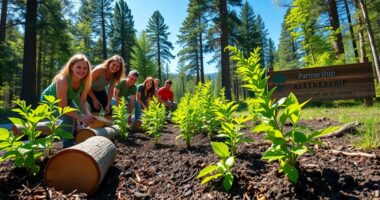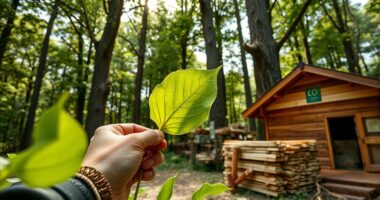If you want to make eco-friendly choices, opt for sustainable wood sourced from responsibly managed forests with certifications like FSC or PEFC. Reclaimed and bamboo woods are excellent eco-conscious options that reduce waste and support renewable resources. Look for transparent sourcing and consider reclaimed or recycled materials to minimize your environmental impact. To discover more about how these choices can benefit your projects, explore sustainable options further and learn how to identify responsible wood practices.
Key Takeaways
- Choose certified wood products with FSC or PEFC labels to ensure responsible and sustainable sourcing.
- Opt for reclaimed or recycled wood to reduce environmental impact and promote circular economy practices.
- Consider fast-growing, sustainable alternatives like bamboo for durability and eco-friendliness.
- Verify sourcing details and origin to avoid threatened or endangered species and support responsible forestry.
- Prioritize local, responsibly managed materials to minimize carbon footprint and support community economies.
What Is Sustainable Wood and Why It Matters
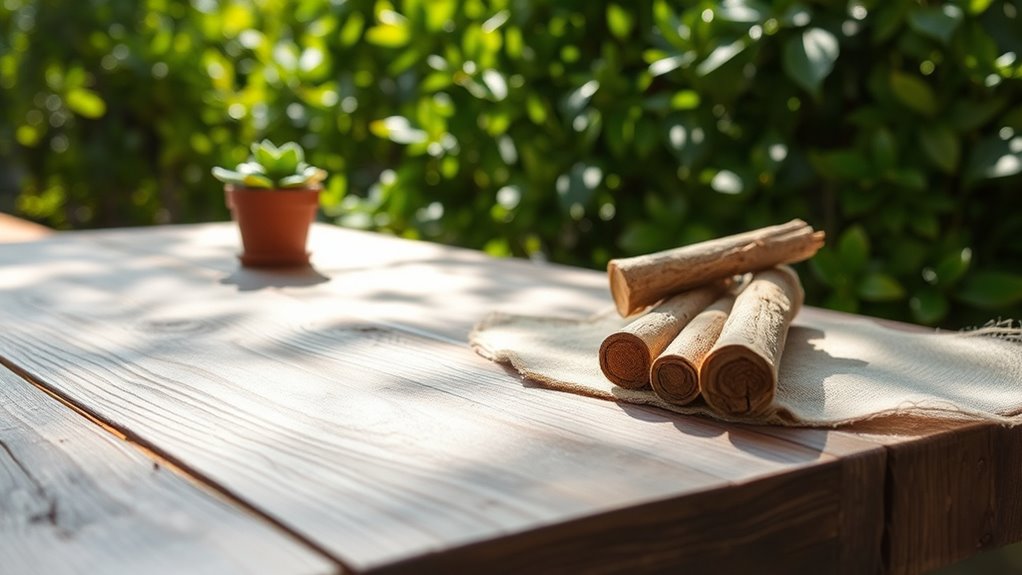
Have you ever wondered what makes wood truly sustainable? It starts with sustainable forestry, where forests are managed responsibly to protect ecosystems, biodiversity, and local communities. Responsible sourcing ensures that every piece of wood comes from well-maintained forests that follow strict environmental, social, and economic standards. This approach helps reduce the environmental impact of wood production by preventing deforestation and promoting replanting. Certifications like FSC and PEFC verify that wood is harvested sustainably, giving you confidence in your choices. Using sustainable wood supports conservation efforts, fair labor practices, and local economies. By choosing responsibly sourced wood, you’re helping minimize habitat destruction, lower greenhouse gas emissions, and promote renewable resources, all essential steps toward a more sustainable future. Incorporating sustainable sound design techniques can also enhance eco-friendly projects by seamlessly integrating natural elements. Additionally, understanding the environmental benefits of sustainable wood can motivate conscious consumers to make more informed decisions. Being aware of forest management practices can further deepen your understanding of how responsible sourcing maintains ecological balance and promotes biodiversity. Recognizing the importance of certification standards can also help ensure your wood products come from truly sustainable sources.
Key Certifications for Eco-Friendly Wood Products
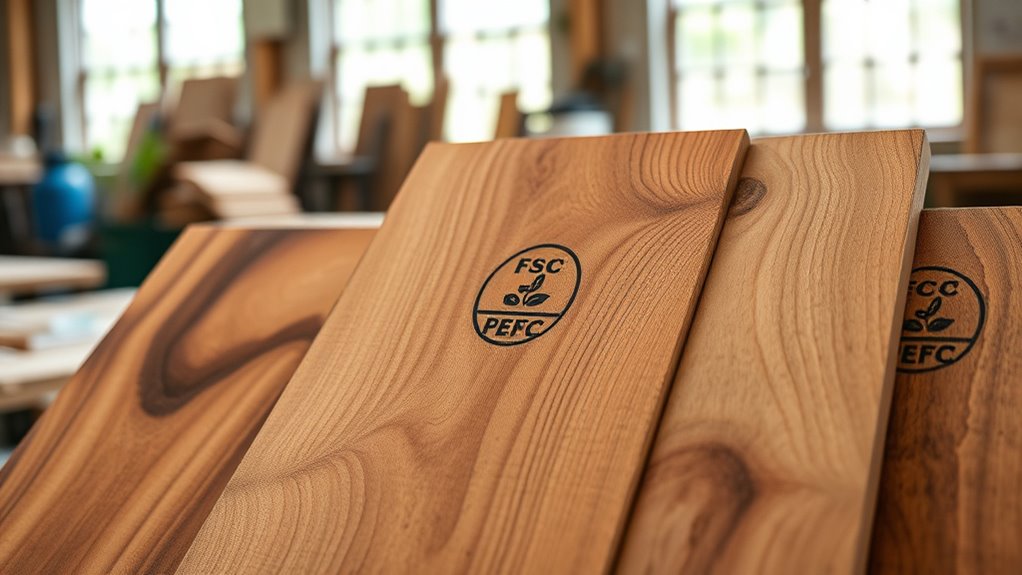
Certifications play a pivotal role in ensuring that wood products are truly eco-friendly. When shopping for sustainable wood, look for trusted certification labels like FSC, which verifies that the wood comes from responsibly managed forests. These certifications guarantee adherence to strict standards that protect biodiversity, water, soil, and community rights. Supporting certified wood encourages responsible forestry practices worldwide and promotes transparency in the supply chain.
Consider these key points:
- FSC certification assures sustainable sourcing
- PEFC is another reputable forestry certification
- Certifications involve rigorous audits and strict criteria
- Certified wood supports environmental and social responsibility
- Choosing certified products helps promote accountability
- Sustainable forestry practices are essential for long-term ecological balance. Additionally, these certifications often include requirements for reforestation and sustainable harvesting methods, ensuring forest regeneration and health over time.
Implementing such standards not only benefits the environment but also fosters ethical sourcing that respects local communities and ecosystems.
Popular Types of Sustainable Wood for Home Projects
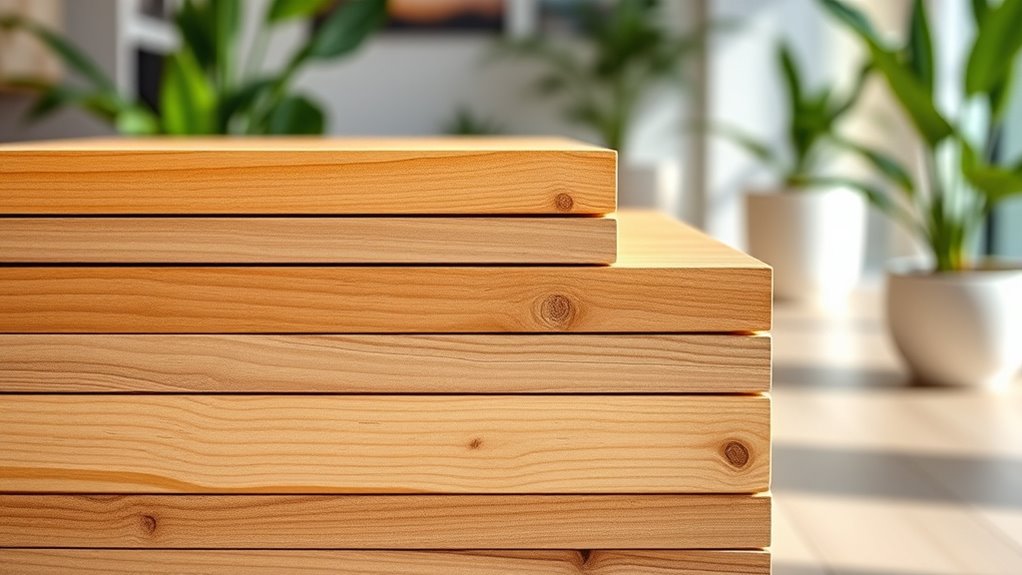
When choosing sustainable wood for your home projects, reclaimed and vintage wood can give new life to existing materials while reducing waste. Bamboo offers a fast-growing, eco-friendly alternative that’s perfect for flooring and furniture. Durable hardwoods like FSC-certified oak, maple, and cherry provide strength and responsible sourcing for long-lasting results. Additionally, floating on water is a sustainable method used to transport and store certain types of wood, minimizing environmental impact. This method often involves water-based transportation, which reduces reliance on fossil fuels and decreases carbon emissions. Proper storage techniques, such as storage in a cool, dark place, can also help prolong the lifespan of the wood and prevent deterioration over time. Incorporating sustainable transportation methods can further reduce the carbon footprint associated with wood sourcing. Implementing proper ventilation during and after installation is essential for maintaining indoor air quality and ensuring safety.
Reclaimed and Vintage Wood
Ever considered using reclaimed or vintage wood for your home projects? Reclaimed wood is salvaged from old structures like barns, factories, and ships, reducing the demand for virgin timber and supporting sustainably managed forests. It adds unique character, with weathered charm and rich patinas that elevate your space’s aesthetic. Using reclaimed wood helps divert waste from landfills and promotes circular economy practices in woodworking. Properly processed reclaimed wood is kiln-dried and treated to guarantee safety, stability, and pest-free indoor use. Vetted options include barn siding, wine barrel planks, and shipping pallets, perfect for flooring, furniture, and decorative accents. Incorporating reclaimed and vintage wood makes your projects eco-friendly and distinctive, aligning with sustainable living principles. Additionally, choosing sustainable sourcing ensures your projects continue to support environmental conservation efforts. Using reclaimed wood also reduces reliance on virgin timber, which helps preserve forests and biodiversity. In addition, eco-conscious choices like these can enhance your property’s value and appeal to environmentally mindful buyers.
Bamboo: Fast-Growing Alternative
Bamboo has become a popular choice for sustainable home projects because it’s a fast-growing grass that can be harvested every 3 to 5 years without harming the plant. Its rapid growth and extensive root system make bamboo a highly renewable resource, reducing the need for replanting and helping prevent soil erosion. Unlike traditional hardwoods, bamboo’s strength-to-weight ratio rivals or exceeds many types of wood, making it ideal for flooring, furniture, and structural elements. With over 1,000 species worldwide, you can choose from varieties like Moso, Guadua, or Tonkin, each suited for different applications. Cultivating bamboo requires minimal water, pesticides, or fertilizers, and it absorbs significant amounts of carbon dioxide, making it an excellent, sustainable, renewable option for eco-conscious homeowners.
Durable Hardwood Choices
Durable hardwoods like oak, maple, and cherry stand out as excellent sustainable options for home projects because of their strength and longevity. These FSC-certified hardwoods come from sustainable species that support responsible harvesting, helping preserve forest health and biodiversity. Black cherry and teak are naturally resistant to wear and moisture, making them perfect for high-traffic areas. Reclaimed hardwoods offer a sustainable alternative by repurposing aged wood with lasting structural integrity. When selecting durable hardwoods, consider fast-growing options like North American oak or white ash, which reduce environmental impact without sacrificing durability. Choosing these sustainable species ensures your projects are both resilient and eco-friendly, giving you long-lasting beauty while supporting responsible forestry practices.
- FSC-certified for responsible sourcing
- Naturally resistant to wear and moisture
- Long-lasting durability for furniture and floors
- Reclaimed hardwoods for eco-conscious reuse
- Fast-growing sustainable species
How to Identify and Source Responsible Wood Materials
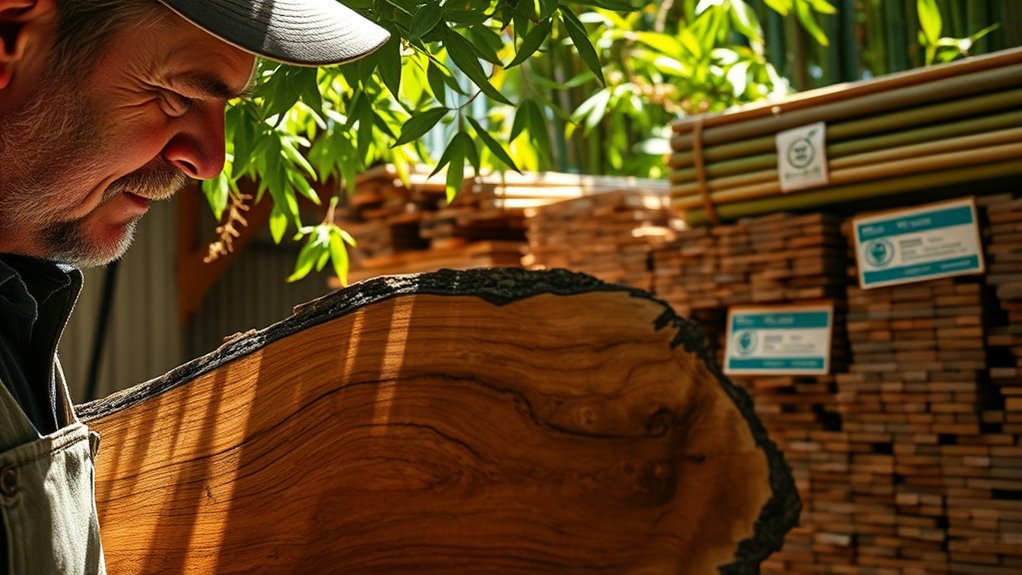
To guarantee you’re sourcing responsible wood, start by checking for certifications like FSC or PEFC labels, which confirm sustainable management practices. Ask your suppliers for detailed information about their sourcing methods and consider opting for reclaimed or recycled wood to reduce environmental impact. Always verify the species and origin to avoid sourcing threatened or endangered woods. Incorporating safety standards for children’s toys when selecting materials can further ensure environmentally responsible choices. Additionally, look for certified sustainable sources to ensure your wood choices support long-term ecological balance. Understanding wood lifecycle and how it impacts ecosystems can also guide more sustainable purchasing decisions. Being aware of the environmental impacts of logging can help you make more conscious choices that support conservation efforts and promote creative problem-solving in sustainable resource management.
Recognize Certification Labels
When sourcing responsible wood materials, it’s essential to look for certification labels like FSC or PEFC on products or packaging. These labels verify responsible sourcing and guarantee the wood comes from sustainably managed forests. FSC certification, in particular, guarantees compliance with strict social, environmental, and economic standards. Recognizing certification labels helps you avoid uncertified wood, which may originate from regions with lax regulations. Always check for a clear, visible logo or label on packaging or tags. Don’t hesitate to ask suppliers or manufacturers for certification details to confirm authenticity. Being diligent about certification labels ensures you’re supporting responsible sourcing and contributing to sustainable forest management.
- Look for FSC or PEFC logos on products
- Verify certification details with suppliers
- Recognize eco-friendly origins at a glance
- Avoid uncertified wood from lax regions
- Support sustainable forest practices
Choose Reclaimed or Recycled
How can you guarantee that reclaimed or recycled wood is sourced responsibly? Start by checking for labels, documentation, or certifications that verify its origin. Reclaimed wood is salvaged from old structures like barns, factories, and pallets, reducing demand for new timber and supporting sustainable sourcing. Ensure it’s been properly cleaned and treated to prevent pests and decay. Look for evidence it was ethically reclaimed, aligning with circular economy principles by extending material lifespan. Use the table below to compare sourcing options:
| Reclaimed Wood Features | Responsible Sourcing Tips |
|---|---|
| Unique weathered look | Verify origin and treatment process |
| Vintage patinas | Seek clear documentation |
| Salvaged from old structures | Confirm ethical reclamation |
| Supports circular economy | Look for eco-certifications |
Choosing reclaimed or recycled wood helps you make eco-friendly, sustainable choices.
Verify Source Transparency
Are you confident that the wood materials you choose come from transparent and responsible sources? Confirming source transparency is key to sustainable sourcing. Look for certifications like FSC or PEFC, which verify responsible forest management and sustainable practices. Research your supplier’s sourcing practices and ask for detailed origin information, including harvesting methods. Use online databases such as The Wood Database or FSC resources to verify the sustainability of specific wood species. Prioritize reclaimed or salvaged wood, which inherently promotes reuse and reduces harvesting. Additionally, traceability in supply chains through documentation such as chain-of-custody certificates can help ensure the wood can be traced back to well-managed forests. Incorporating vetting processes into your procurement routine further helps ensure your wood choices support eco-conscious practices. Staying informed about supply chain transparency is essential for making responsible material choices.
Environmental and Practical Benefits of Choosing Sustainable Wood
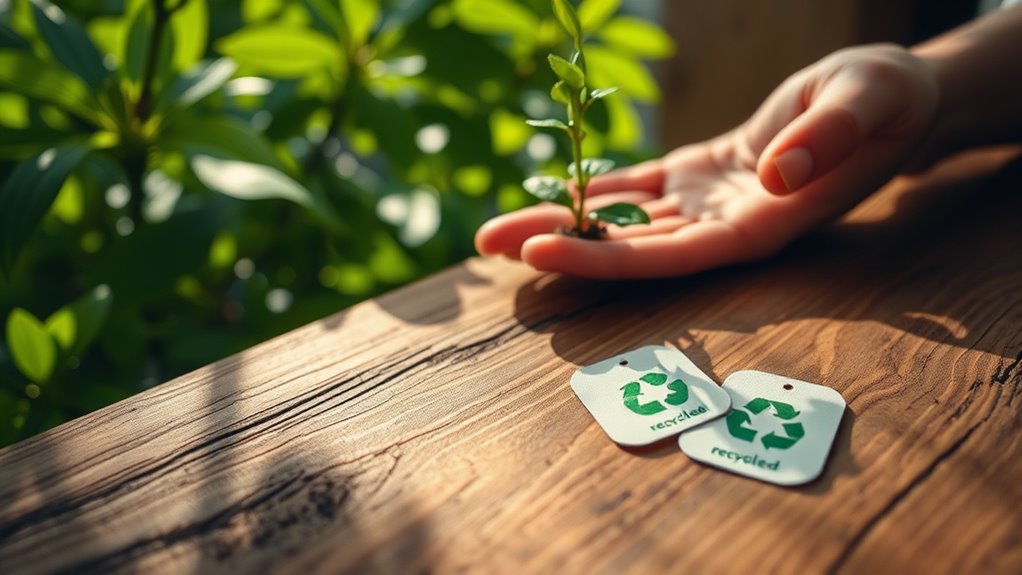
Choosing sustainable wood offers significant environmental and practical benefits that make it a smart choice for eco-conscious consumers. Sustainable wood supports biodiversity and reduces deforestation, helping preserve essential ecosystems. It often has a lower carbon footprint because it’s sourced from responsibly managed forests or reclaimed materials. By choosing certified sustainable wood, you help promote long-term forest health, encouraging regeneration and protecting wildlife habitats. Additionally, sustainable wood tends to be more durable and long-lasting, which means fewer replacements and less waste over time. When you opt for sustainable wood, you’re not only making an environmentally responsible decision but also contributing to climate change mitigation. Responsible forestry practices ensure that your choices benefit the planet while providing high-quality, practical products for your needs.
Alternatives to Conventional Hardwood and Softwood
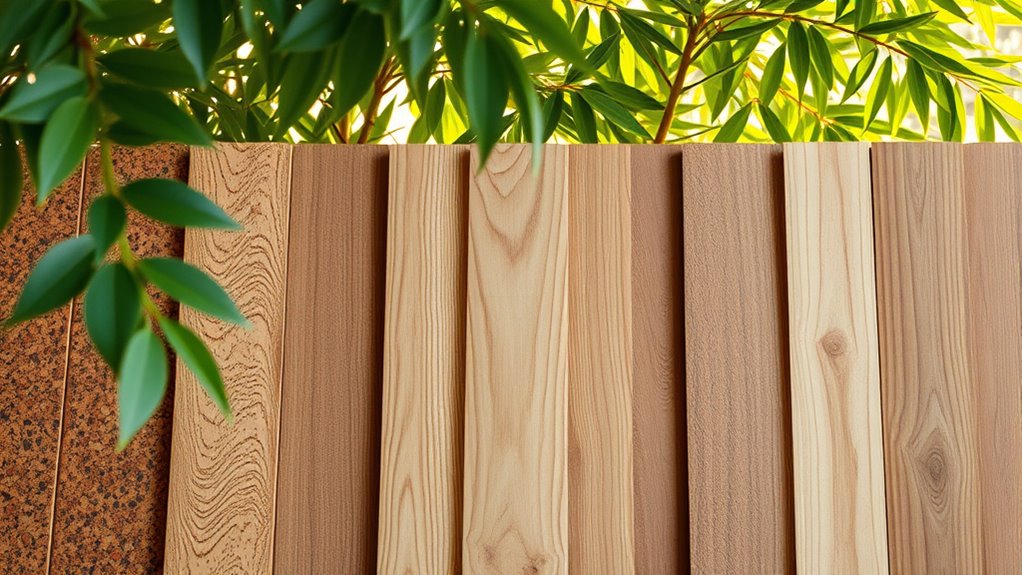
When seeking sustainable alternatives to conventional hardwood and softwood, options like bamboo, reclaimed wood, and fast-growing softwoods stand out. Bamboo, a fast-growing grass, matures in just 3-5 years, making it a highly renewable choice. Reclaimed wood repurposes existing timber from old structures, reducing the need for new harvests and minimizing environmental impact. Sustainable hardwood species such as FSC-certified oak, maple, and black cherry are harvested responsibly to promote forest regeneration and biodiversity. Fast-growing softwoods like pine and fir are eco-friendly because of their rapid growth and sustainable management practices. By choosing these alternatives, you support responsible forestry and reduce your ecological footprint.
- Bamboo for quick renewability
- Reclaimed wood from old structures
- FSC-certified sustainable hardwoods
- Fast-growing softwoods like pine and fir
- Salvaged and recycled timber
Tips for Incorporating Sustainable Wood Into Your DIY Projects
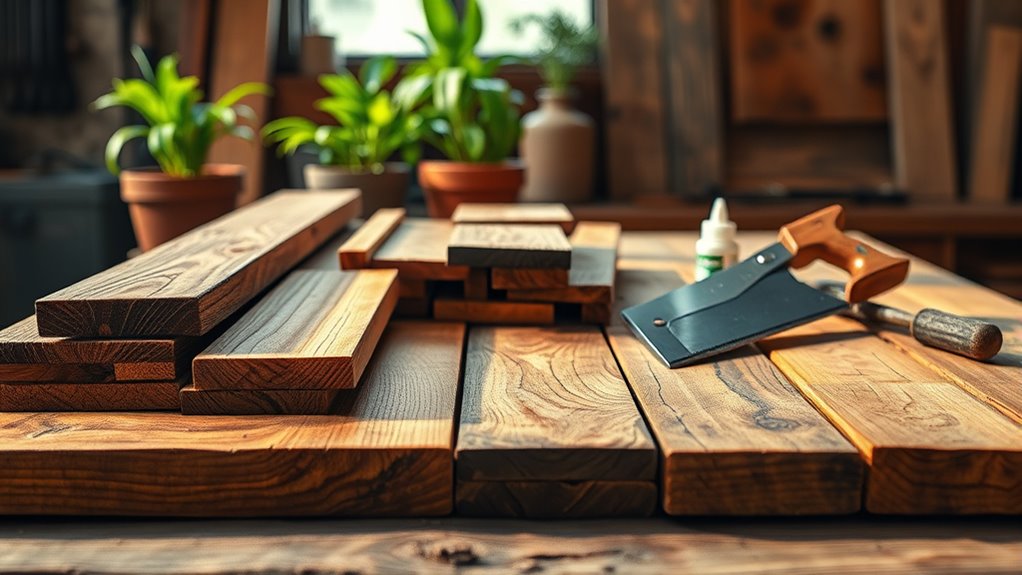
Incorporating sustainable wood into your DIY projects begins with selecting responsibly sourced materials, such as FSC-certified or reclaimed wood, to support forest health and reduce environmental impact. Look for eco-friendly materials like bamboo or fast-growing species like poplar, which have rapid harvest cycles and minimize resource depletion. Using recycled or salvaged wood scraps extends the lifespan of existing materials and cuts waste. To further boost your project’s sustainability, choose eco-friendly finishes and stains, such as low-VOC options like Rubio Monocoat, which improve indoor air quality. Whenever possible, source your wood locally to decrease transportation emissions and support regional forest conservation. These tips help guarantee your DIY projects are both beautiful and environmentally responsible, aligning with your eco-conscious values.
Frequently Asked Questions
What Is the Most Eco-Friendly Wood to Use?
When choosing the most eco-friendly wood, you’ll want to pick options that minimize environmental impact. Bamboo stands out because it grows rapidly in just a few years without replanting. Reclaimed wood is another excellent choice, repurposing existing materials and reducing waste. FSC-certified hardwoods like oak or maple are sustainable, coming from responsibly managed forests. Softwoods like pine and fir also offer quick growth and sustainable harvesting, making them good eco-friendly options.
What Is the Most Eco-Friendly Hardwood?
When selecting the most environmentally friendly hardwood, consider options like American hardMaple and oak. They grow quickly and are managed sustainably, reducing environmental impact. FSC-certified hardwoods, such as FSC oak and FSC cherry, guarantee responsible harvesting. Reclaimed hardwoods and those from well-managed forests also minimize harm. While slow-growing woods like teak are less eco-friendly unless responsibly sourced, fast-growing species like bamboo offer sustainable alternatives.
What Are Sustainable Woods?
Ever wondered what sustainable woods truly are? They’re harvested responsibly from forests that prioritize environmental health, social equity, and economic stability. You’ll find options like reclaimed wood, bamboo, and fast-growing species such as poplar. These woods are sourced through methods that promote regeneration and reduce environmental impact. By choosing sustainable woods, you play a part in preventing deforestation and supporting ecosystems, ensuring future generations can enjoy the forest’s beauty and resources.
How Can We Make Wood Environmentally Friendly?
To make wood environmentally friendly, you can choose options like certified FSC wood, reclaimed or recycled wood, and fast-growing species like bamboo. Support sustainable forestry practices such as selective harvesting and replanting, which help maintain forest health. Additionally, use eco-friendly finishes and treatments to reduce harmful chemicals and extend the lifespan of your wood products. Your choices can markedly reduce environmental impact and promote conservation.
Conclusion
Choosing sustainable wood is like planting a seed for a greener future; every small step you take helps protect our planet. By understanding certifications, sourcing responsibly, and exploring eco-friendly options, you’re not just building furniture—you’re building a legacy of care. Your choices ripple outward, making a difference far beyond your home. So, embrace sustainable wood, and let your projects be a demonstration of your commitment to a healthier Earth.



